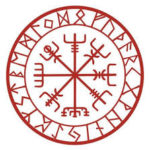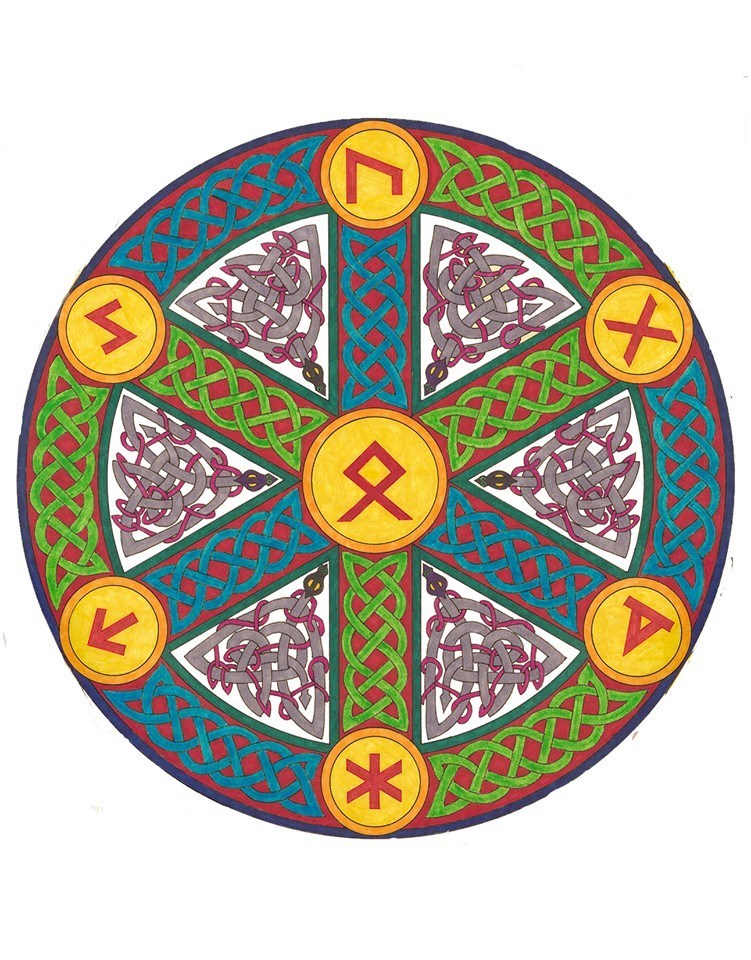The Gods of the North
All the gods and goddess were not worshipped equally, many of the gods Snorri Sturluson described are known only from the Viking age; others were worshipped centuries earlier. Odin was more popular in Norway and Denmark, Frey in Sweden, Thor in Iceland and Germany. It is still possible to pull together a list of Asatru’s essential deities, but first we must explain the two main families or clans of Gods, and their roles.
The Aesir and Vanir
The Gods and Goddess of the north break down into two tribes, The Aesir and the Vanir. The Aesir are more involved with force and rulership and are associated with the sky. These include; Odin, Frigga, Thor, Balder, and Tyr. The main Vanir deities are Njord, and his children, Frey and Freya. All three live with the Aesir in Asgard, and the other of the Vanir live in Vanaheim, although we know virtually nothing about them. The Alfar or elves seem to be related to them. The Vanir are associated with fertility- of humans, animals, crops, and the seas. At one time the Aesir and Vanir were at war, and as part of a peace treaty between the tribes, the gods of the Vanir that live in Asgard were sent as hostages.
Odin
Wotan, Odin, the Allfather- he has a special place among the holy powers. His might and main sparked the breath of our life and provided the inspiration for our soul. He is the fury in battle, the chooser of the slain, and the God of victory. He has sacrificed himself to win the runes, his eye to Mimir’s well for knowledge and tricked the giantess Gunnlod to drink the mead of inspiration. He walks the Nine worlds both physically and spiritually, always pushing the boundaries of what is comfortable and safe in order to learn and grow. He is a spiritual force throughout the land and the leader for our folk. His example inspires us towards a life of relentless betterment, and power through strength and knowledge. He is on an unending quest for knowledge and immortality. Wotan is not a God for everyone, all revere him but few will choose to walk the path he leads. The Havamal says:
“It is best for man to be middle-wise, Not over cunning and clever:
The learned man whose lore is deep Is seldom happy at heart.”
This stanza says it all, if you choose the path of an Odian there is always a heaviness that you must learn, the runes will call to you. The realization that everything you have been taught is a lie could make you insane. Strict discipline is required, there is no joy, but there is a fulfillment in life’s purpose and a burning desire to transcend this life with your consciousness intact and become divine.
To honor him in the religious will give you wisdom, to follow him in the esoteric will give you enlightenment, and immortality.
TYR
Tyr is the God of war and right action. The major myth concerning Tyr is that of Feneris the giant Wolf. He was taken in and raised by the gods, especially Tyr, but as he grew, and grew and the gods became worried and were threatened by him. So, they devised several games designed to trick the wolf into being bound, but he was able to break all of them. Finally, the gods went down to the Dwarves (who are amazing craftsman and create all sorts of magical items) and they created a ribbon that would restrain the wolf. The gods took the ribbon to the wolf and taunted him saying that he should easily be able to tear the ribbon as he had the chains, but the Feneris sensed something wanted a guarantee. One of the gods would have to place his hand in his mouth. Tyr unhesitatingly stepped forward and put his sword hand in his mouth, the wolf was bound, and Tyr ended up losing his hand. The Warrior’s lot is to sacrifice for his community, he or she goes in harm’s way, knowing that death may be the result. Tyr represents courage, honor, and duty. His rune stave was carved on swords and spears in early Germanic history, it is the original “Victory rune”.
THOR
Thor, son of Odin and the giantess Jord is known as “the friend of Man”. While Odin is the god of Aristocrats and Heroes, Thor is the patron of the common man and woman. He was known as Donar by the Germans, and Thunor by the Angles and Saxons. He wields his hammer Mjolnir with the power of lightning, it never misses and always returns by magic. He wears Iron gloves and a belt “Megangirth” that doubles his strength. He is the archetypal warrior, tasked with defending those to his care. He protects the worlds of the Gods, and that of humans, from all threats. Including numerous giants, he is often “journeying in the east” seeking his prey, but his arch-enemy is the World serpent, Jormangundr. The snake is a child of Loki and stretches around the world on the ocean floor, when Ragnarök comes they will battle and kill each other.
Thor’s hammer has come to symbolize protection and holiness. This power extends to actual ritual hammers, to hammers carved in stone, and even to hammer-like gestures made with a fist. Miniature amulets in the shape of Mjolnir were worn as necklaces for protection, or to give the wearer Thor’s strength and boldness. While hammer-shaped objects go back into antiquity, they also seem to have become a specifically pagan answer to the cross of Christianity. Thor was spoken of as doing single combat against Christ. A thousand years later, the hammer is worn by those who follow Asatru.
Thor and his hammer also represent fertility, that of humans, the fields, and livestock. The lightning flashes over the fields and brings life-giving rains that make the crops grow. He represents strength; strength to endure, perseverance, and will power. Thor can be our guide to strength and the boldness to use it.
FREYA
Freya is the best-known Goddess of the German folk, she is love, beauty and a goddess of war. She is the leader of the Valkyrie and has the first choice among the slain in battle and takes them to Fokfang, where she resides in Asgard, the other half go to Valhalla. Her rune is Berkano, Berkano is beauty, gestation, it is a source of new beginnings. It is the rune of concealment and protection. It is the womb wherein the individual grows insight and new wisdom. Freya is Life, she reminds us to enjoy ourselves, and that life is not just about struggle and valor. She reminds us to sing and dance, to make love and music and poetry; to enjoy all the beauty and passion around us. She reminds us to be in our bodies and feel the emotions and sensations that we can only feel as human beings here on Midgard. She reminds us what we are fighting for. She reminds us to LIVE
FREY
Frey is Freya’s brother. Frey personifies fertility, prosperity, peace, and pleasure. The Prose Edda tells us “Frey… rules over the rain and the shining of the sun, and therewithal the fruit of the earth; and it is good to call oh him for fruitful seasons and peace. He governs also the prosperity of men.” Frey’s powers lie in the realms of fertility, wealth and pleasure but he can be a fighter as well. The best-known story of Frey is of him wooing the giantess, Gerd. While sitting Odin’s seat which looks over all things, Frey sees Gerd and is instantly smitten. He persuades Skirnir to ride to the land and plead Frey’s case for marriage. Gerd denies proposal after proposal, but when faced with a terrible curse she agrees to wed. Frey in turn gives Skirnir his magical sword that can fight by itself. Another story about him where he fights a giant named Beli with an antler and kills him. At Ragnarök it said that he will greatly miss his sword when he fights the fire giant Surt.
Frey has connections to kingship and sovereignty, under the name Yngvi-Freyr, he is known as the divine ancestor of the Yngling dynasty of ancient Sweden. Farmers, gardeners, herdsmen and all who make their livelihood from the land, can call upon Frey. All who want prosperity, should seek the blessings of Frey.
EASTER (OSTARA)
Easter or Ostara was a Goddess of the Angles and Saxons. She is honored at the Spring equinox, Christianity stole her festival for the resurrection of Jesus. The Easter bunny is said to have been the bird which at one time drew the chariot of the Goddess of Ostara and was turned into a hare. Every year however, at the coming of spring the hare remembers, and in commemoration of its original bird nature lays eggs as an offering to Spring and the Youth it symbolizes. Eggs during the festival were thrown high into the air and if caught would mean good luck for the upcoming year.
NERTHUS
NERTHUS (also called Frigga, the wife of Odin) is a Germanic goddess of the earth, and she is mentioned in Tacitus’ Germania. Tacitus wrote that Germans drove a wagon bearing Nerthus, concealed in a draped sanctuary, and wherever she went there was peace and festivities.
Practicing Asatru’
There are two main Rites in Ásatrú: the Blot and the Sumble. Daily workings of Asatru’ include; donning the hammer, greeting the sun-Sunna, and blessings over meals. I also set aside time in the morning to remember ancestors that have gone on before me, mainly my grandparents. The spirits of the dead are with us a`nd they like us to speak with them and let them know what we are doing. They offer guidance when asked or just give us their presence. There are runic combinations that can be used to access the dead, the spell-songs of Odin spell out several magical formulas. Other cultures around the world have familial alters, ours did as well. Leaving them gifts of alcohol, water or coffee in their honor as a sacrifice and appreciation of what I have been blessed with in my life.
The purpose of ritual is to get your mind and body into the correct vibration to contact with the universe, gods or ancestors. All of my daily personal rituals I perform in German, the language of my Ancestors. Though this is not necessary and one is free to say and do these things in their native tongues.
Written By Joe Rozanek


